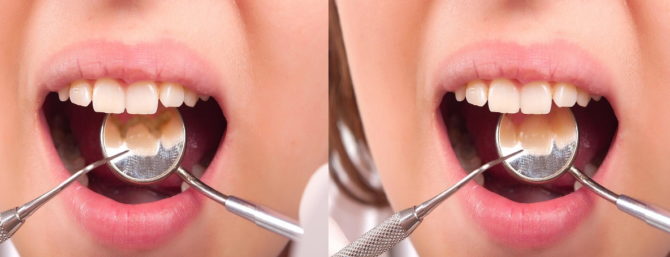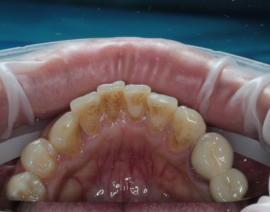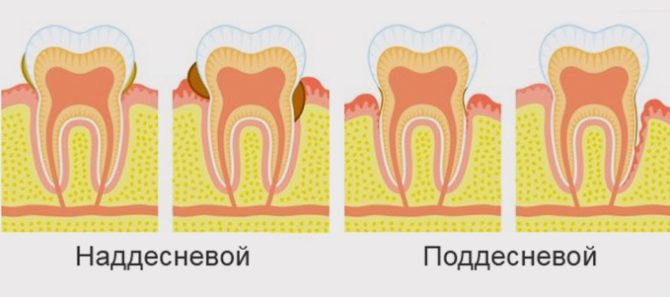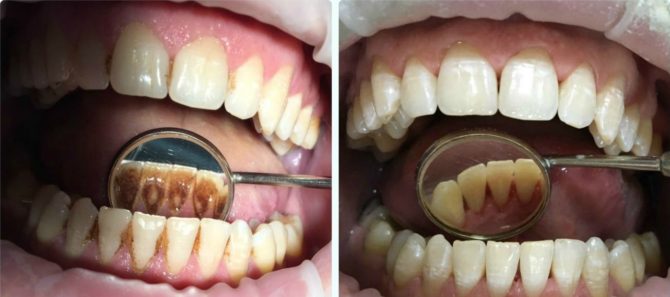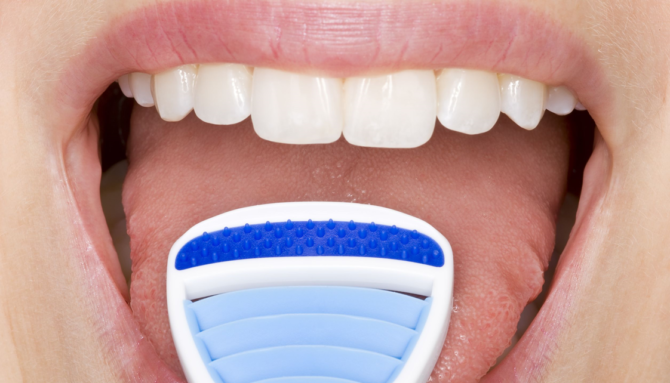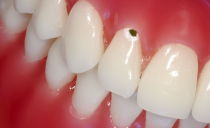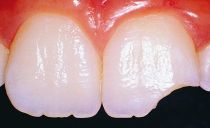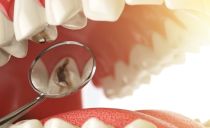Tartar: what is it, reasons, how to fight
Tartar - plaque hardened over time. Its composition contains salts of calcium, phosphorus and iron, bacteria, food debris. You can clearly see what tartar is in the photo before and after its removal. After completion of professional processing, the tooth returns to its original shape, restores color.
Content
Reasons for the appearance of hardening plaque
The main reason for calculus formation is incorrect or inadequate hygiene. Brushing too soft with a brush, ignoring suitable dental floss, and using poor-quality toothpaste are all causes of tartar in humans.
In addition to behavioral characteristics, doctors identify some physiological reasons:
- chewing on one side due to orthodontic or dental problems;
- incorrect functioning of internal organs, impaired metabolism - this is why tartar appears in people with impaired salt metabolism;
- abnormal position of teeth, due to which at home it is not possible to completely remove soft plaque from enamel;
- natural rough surface of the teeth, contributing to the formation of stone and plaque.
Orthopedic constructions are also included in the list of why tartar is formed on the teeth.
Mechanism of occurrence
When chewing, most of the surface of the teeth is cleaned "independently" - from contact with solid food. However, not all places are equally accessible. Deposits from bacteria and food debris gradually accumulate on the necks of the teeth and on the roots without proper oral hygiene. The mucus naturally present in the oral cavity sticks them together, turns them into a viscous mass that is difficult to remove. Subsequently, the mass hardens and forms a solid coating on the teeth.
Stages
Outwardly, such formations are not immediately noticeable. Having appeared for the first time, microbial plaque is mineralized within 12–16 hours. Hardening time depends on the physiological characteristics of the body. The only way to pause the process is to thoroughly clean the oral cavity, including the tongue and gums.
At the next stage, dental deposits can also give out nothing. And only during professional brushing the doctor sees a slight browning, changes in the shade of enamel. At this stage, the nucleation of apatite crystals formed by a chemical reaction between phosphates and calcium occurs. It lasts from 40 to 60 days.
At the next stage, dark spots are visible to the naked eye, they can be found on the outside and inside close to the gums. The duration of the formation of visible deposits varies from 5 to 6 months.
The last phase of tartar formation is the saturation and strengthening of crystals. During this period, the growth of hard plaque in the gingival pocket is possible. And the stones in the gums are the cause of periodontitis.
How to recognize
In order not to waste time on independent research, studying what a stone looks like on teeth, it is recommended to regularly seek dental care.In most cases, this is an effective prevention of tartar.
Small deposits can easily be made visible with a cotton swab moistened with iodine. But only dentists can fix their presence in periodontal pockets.
In the last stage, several symptoms appear at once:
- smell from the mouth;
- the mobility of one or more teeth;
- redness, cyanosis and bleeding gums;
- discomfort during chewing food;
- sensitivity increase - reaction to citric acid, hot dishes, cold drink.
Often tartar has jagged sharp borders, causing the tongue to be injured, there are unpleasant sensations that impede articulation.
Classification
Tartar and the causes of its occurrence are different. In classical dentistry, it is customary to distinguish two types: subgingival and supragingival. Each of them has its own characteristics and is determined by different diagnostic methods.
Subgingival tartar
This type of plaque is recognized as especially “insidious”, as it forms out of sight: below the upper level of the gums. Dentists determine subgingival plaque using a probe. In addition, it is clearly visible in gum recession, when the roots and necks of the teeth open due to a decrease in soft tissue. Practice shows that subgingival stone in most situations has a dark color and high hardness.
Gingival Tartar
This type of tartar is located above the edge of the gums. In most cases, the supragingival plaque is hard or clay, has a light yellowish tint. A surface examination is sufficient for diagnosis. It is the supragingival stones that become the reason for going to the doctor. And already during the study, the doctor may suspect the existence of hidden defects.
This is how the supra-gingival stones on the teeth look - photos before and after cleaning:
How to delete
Large stones on the teeth - the cause of the appearance and development of gingivitis, periodontitis. Because of them, inflammatory processes develop, hard tissues of teeth are destroyed, gums and cheeks suffer. It can reach a serious condition such as phlegmon cheeks.
Complications are serious, but an ordinary toothbrush cannot solve the problem. Therefore, it is better to take the help of a hygienist on time. Four methods are known:
- Mechanical impact. Today in Moscow it is used extremely rarely, as it is traumatic and outdated.
- Chemical treatment. Elimination of growths with potent chemicals.
- The use of ultrasound. By acting on stone plaque with ultrasonic waves of different frequencies, the dentist destroys it without harm to the enamel.
- Laser exposure. The method is expensive, so many clinics do not offer complex treatment, but a separate laser cleaning of one tooth.
Home procedures, the description of which are full of articles on the Internet, are ineffective. They are suitable only for the prevention, prevention of disease and the fight against bacteria. And certainly not a single home method is suitable for removing subgingival stones.
Who to contact
The most qualified hardened plaque removal specialists are periodontologists. Their specialization is gum disease. Therefore, they better cope with subgingival deposits. To remove supragingival, the qualifications of a hygienist or dentist are sufficient.
Additional treatments
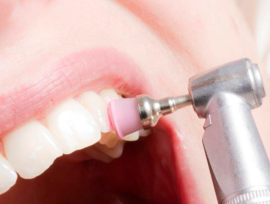 After removal, polishing is required. Freshly cleaned enamel has a porous surface in which microbes, mucus, and epithelial cells accumulate. Excellent conditions are created for the re-formation of plaque. To avoid this, traditional polishing is performed.
After removal, polishing is required. Freshly cleaned enamel has a porous surface in which microbes, mucus, and epithelial cells accumulate. Excellent conditions are created for the re-formation of plaque. To avoid this, traditional polishing is performed.
An analogue to this is the treatment with an apparatus that delivers a thin stream of a mixture of water, air and the smallest abrasive particles under pressure. If the clinic does not polish the enamel after removing the tartar, it is worth looking for an alternative.
After uninstall
For two weeks after getting rid of plaque, it is recommended to abandon products that affect the color of enamel. In this period, it is especially susceptible to dyes. Vivid examples of such products: red grape wine, coffee, hard-boiled black tea, beetroot and carrot juices.
Prevention
Tartar and the consequences of its growth can cause tooth extraction, its complete loss. Therefore, the prevention of plaque accumulation should be carried out regularly. To do this, you must:
- quit smoking so as not to expose the enamel to the harmful effects of tobacco smoke;
- brush your teeth twice a day;
- rinse your mouth after eating;
- use brushes of medium and high rigidity;
- include solid foods in your diet, including raw vegetables;
- apply dental floss for thorough cleaning of the interdental and gingival spaces;
- treat cervical caries on time.
If these simple rules are not followed, a plaque forms, which is why stones appear on the teeth. And, most importantly, preventive examinations should not be missed. Every six months, the oral cavity should be examined by a dentist with access to modern equipment, high-tech tools.
How to brush your teeth
Brushing the teeth several times with a brush with paste is not enough. For external, internal and chewing surfaces it is necessary to make different movements. An example algorithm looks like this:
- After eating, small particles of ingested food remain in the oral cavity. This is one of the reasons why tartar is formed. Therefore, it is better to get rid of them by rinsing your mouth with water several times.
- External surfaces are cleaned strictly by vertical movements from the gum to the tooth. In this way, you need to process the front parts of the upper and lower teeth.
- Then, having unfolded the brush, it is necessary to clean the inner zones in the same way.
- Then, with translational horizontal movements, the chewing surfaces are cleaned.
Bacteria also remain on the tongue. And this is another reason why tartar appears. To clean the tongue, brushes with a raised back are available. She removes possible contamination. There are also special devices, as in the photo:
In conclusion, flossing is good. It removes what is inaccessible to the brush and saturates the teeth with fluoride.
Tartar in children
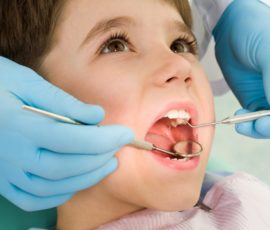 Few of the kids love to brush their teeth and do it without a reminder. But stone coating is not uncommon for them. Therefore, it is necessary to explain why a gum stone may appear on the teeth from an early age.
Few of the kids love to brush their teeth and do it without a reminder. But stone coating is not uncommon for them. Therefore, it is necessary to explain why a gum stone may appear on the teeth from an early age.
The consequences of calculus formation in children are the same. But there may be more reasons. This is an addiction to sweets, excessive consumption of carbonated drinks, unwillingness to take solid foods. Mandatory is the timely introduction of raw carrots, apples, nuts into the child’s diet, limiting soda and sweets.
How to brush teeth for children
In order not to guess why tartar appeared, you need to properly care for the baby's teeth. Up to 6 years old cleaning is carried out by adults:
- The front and rear surfaces of the upper and lower teeth are machined in a circular motion.
- Chewing zones are cleaned horizontally.
Dental floss is allowed for use only after 8–9 years, when a grown child is fully aware of its actions, can track sensations.
What else to look for
It happens that with timely and well-maintained hygiene, a person suffers from excessive plaque. In such situations, experienced dentists refer patients to a GP or gastroenterologist. The goal is to confirm or rule out diseases of the gastrointestinal tract. They often become the cause of the colonization of the oral cavity with harmful bacteria.
Antibiotics can provoke the formation of tartar. Destroying the microflora, they contribute to the multiplication of pathological microorganisms.Those, in turn, settle on enamel and are actively involved in the process of sediment accumulation.
Tartar and pregnancy
The best option would be a complete sanitation of the oral cavity during preparation for the conception of the baby. But if pregnancy has come earlier, do not postpone a visit to the dentist until childbirth. Stones and, to a greater extent, their complications affect the onset of inflammatory processes. Microbes can spread to the fetus. And this is fraught with sad consequences.
Today, there are gentle methods that use application anesthesia, gently cleansing enamel acid solutions. Expectant mothers are available ultrasonic cleaners, which are best done in the second trimester.
Beginning of pregnancy and prenatal weeks are not the best time for calculus removal. Active dental care during these periods can only be urgent: with severe pain, severe inflammation.
Clinic cleaning cost
Tartar control is not an expensive event. Ultrasound treatment of the oral cavity will cost, on average, three thousand rubles. Laser removal will have to pay twice as much. Save money and teeth - visit the dentist on time!

